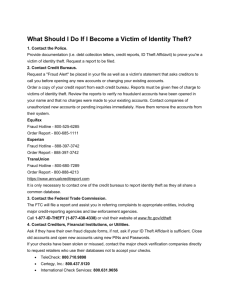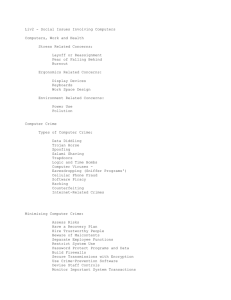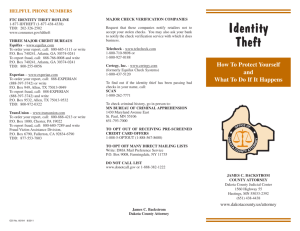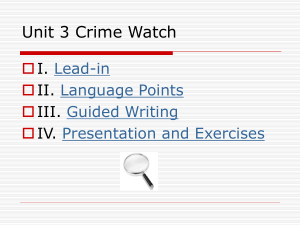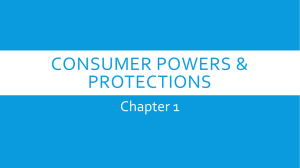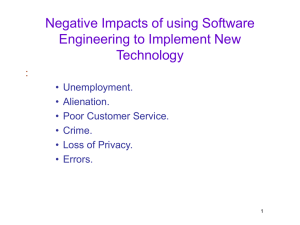The Power of the Consumer
advertisement
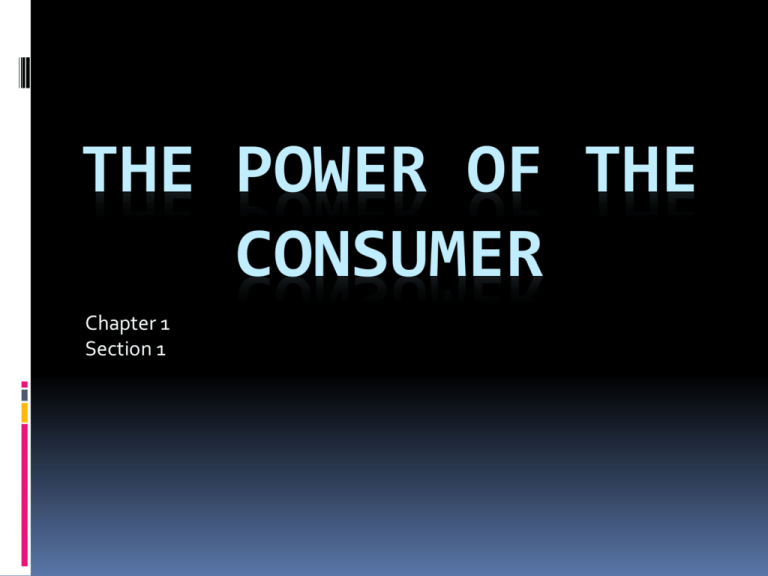
THE POWER OF THE CONSUMER Chapter 1 Section 1 You’re a Consumer As a consumer you use goods and services. Goods– physical objects that are produced. Services—actions that are performed for someone, such as repairing a car, serving a meal, or caring for a child. You each play three key roles! Consumer Worker—the producer of goods and services. Citizen—You use public services such as schools and roadways. You pay taxes in order to pay for these services, and you have the right to vote for elected leaders. The Power of the Consumer Individually the power of each consumer may seem small, but collectively, the purchasing decisions made by consumers have a huge impact. Consumers buy a businesses product leading to profit for the business, the business then pays current works and hired new one. These workers in turn become consumer spending money and continuing the growth of the economy. During this time the business focus on developing new and better products to please the consumers. Teenage Consumers Have played a very vital role in the economy. Teens are now estimated to spend of $170 billion dollars each year. Because of this marketing often targets teenagers. School Technology and the Consumer Technology has change the way consumers buy. Consumers are able to get information at a faster rate and greater amount through TV and the internet. Consumers are also faced with more decisions and easier methods for purchase, leading to more impulse buying. What makes an Effective Consumer! Effect consumers set goals—they decide what they want and how to best carry out this plan. Effect consumers think critically—They make decisions based on careful consideration of the alternatives and their possible outcomes. Effective consumers do their research—they read, observe and ask question. What makes an Effect Consumer! Effective consumers manage everyday finances—they handle their income, expenses, taxes, banking, and credit in a responsible way. Effective consumers plan for financial security—They set up savings, investing and insurance plans. SAFEGUARDING YOUR PRIVACY Section 1.3 Identity Theft One of the most significant threats to personal security is IDENTY THEFT!!! SOCIAL SECURITY NUMBER: this a unique nine digit number that is used by the SS administration to keep track of what you earn. It can be used to access bank and credit card records as well as other personal information How it Happens!!! HOW INFORMATION IS OBTAINED HOW THEY USE THAT INFORMATION *Stolen wallets and purses *Stolen Mail *They change your mailing address *Information taken from your garbage *Finding and stealing personal information from your home. *Stolen information from the internet. *They pose as those you should trust with the information. *Looking over your shoulder *They open a bank account in your name, and write bad checks. *They forge checks and drain your bank account *They order phones and wireless services in your name. *They run up bills for which you become responsible. Preventing Identity Theft Handle mail with care Keep items with personal information in a safe place or locked drawer. Safeguard sensitive information on your computer or online with passwords that include both numbers and letters. Don’t give out personal information through unsafe means. Use only secure website; shttp:// or https:// Ask service provides for safeguards. Before you discard receipts and other personal information shred it. If Your Identity is Stolen File a report with the police Notify your bank and credit card company Call the three major credit reporting agencies—Equifax, Experian, and TransUnion Call the FTC How Companies Use the Information You Provide Reputable business keep credit card numbers secure and don’t share them with anyone. Your name, address, and purchasing history in its customer database for its own marketing purpose. The company might sell your name and address t other retailers, either directly or through data-collection companies. Your responses to product survey’s may be used in future mailings. Protecting Your Privacy Financial Services Modernization Act: Passed in 1999 Requires companies involved in financial activities to send privacy notices to customers. These notices must explain company policy regarding the sharing of customers’ personal information with other business. Online Profiling A practice in which companies collect information about the Web sites people visit, and then use that information to predict what the consumers may buy in the future. Cookies, small files that are stored on your computer's hard drive when you visit a site. Protecting Your Privacy Children’s Online Privacy Protection Act of 1998 IT requires website directed at children under 13 to post their privacy policy through a link on their home page and anywhere personal information is being collected. Internet Safety Taking steps to prevent online harassment and to deal with it if it occurs . Reveal as little personal information as possible. Share your primary e-mail address with trusted friends and family. Watch what you say online. Avoid creating enemies. Use the preference options to block transmission of mail, chat or instant messages from anyone who persists in bothering you. If someone is harassing or threatening you, save the communications as proof. RECOGNIZING DECEPTION AND FRAUD Section 1.4 Deceptive Advertising This is advertising that is likely to mislead consumers through false statements, omitted information, or other unfair means. Deceptive advertising is illegal, and the FTC is empowered to stop it. Bait and Switch False promise of free gifts Deceptive pricing Hidden catches. Fraud Fraud is deceitful conduct designed to manipulate another person for some gain. Pyramid scheme A common example of fraud is the pyramid scheme, an illegal get-rich-quick plan. Chain Letters This is a message sent via postal mail or e- mail that instructs the recipient to send copies to a certain number of other people. Reporting Deception and Fraud If you suspect deception or fraud rather or not you actually fall victim report the situation. Resolving Consumer Conflict Step to consumer conflict: Contact the merchant verbally Write a letter of complain with a follow-up if needed. Move to dispute resolution: Mediation and Arbitration. (Binding Arbitration.) Next seek legal action if neccessary Legal steps to resolution Small claims court—This is a court where you can settle disputes of small dollar amounts. These cases are handled my a judge. (Think Judge Judy), in Illinois these courts handle disputes under $10000. Lawsuit—These actions are sought when the amount of damage or goods reaches over the amount small claims courts can handle. Class Action Suits—A lawsuit filed on behalf of a group of people who all have the same complaint. (Erin Brockovich) Review Assignment Reviewing Key Terms and Ideas #1-15 Thinking Critically #3 (Make sure this one appears in proper sentence and paragraph form. It will require thought and I expect answers that show that.)


